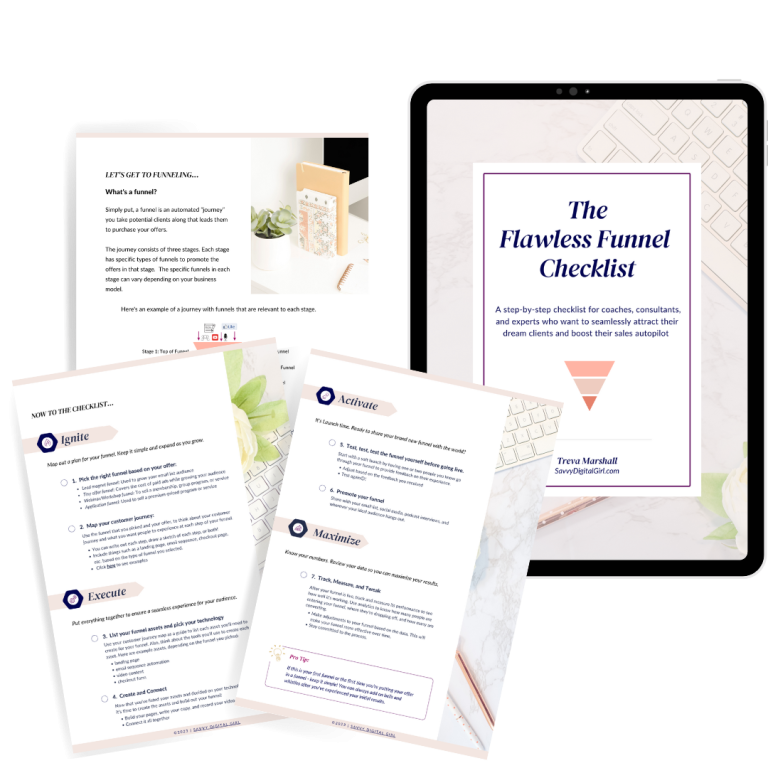7 Funnel Mistakes to Avoid With Your High Ticket Offer

If you’re about to create your first or next funnel to sell your high-ticket offer, there are several mistakes that even the most seasoned online business owners make that you’ll want to avoid.
In this post, I’ve put together a list of common funnel mistakes and how to avoid them. By keeping these mistakes top of mind, you’ll not only have a foundation for success, but you’ll also save time and money upfront. You’ll also have a better understanding of how to create an effective sales process that drives conversions and increases revenue.
Why these funnel mistakes matter
If you sell high-ticket offers (courses, coaching programs, or services that are $2k+), it’s super important to stay on top of every aspect of your sales funnel. This is because potential customers are more likely to abandon the sales process when it comes to higher priced offer.
According to a study by Salesforce, a whopping 68% of businesses remain in the dark about their conversion process.
Not having a good understanding of your funnel will cause you to miss out on opportunities to increase your sales.
So let’s dive in so you can avoid these common sales funnel mistakes.
Mistake 1: Ignoring the Importance of A Proven Offer
One of the most critical mistakes businesses make is not understanding the importance of using a proven offer when it comes to using a funnel to sell a high ticket offer.
A proven offer is an offer that has already been sold and shown to be successful in attracting and converting customers. A sales funnel will not fix a low converting offer. A funnel is meant to amplify the selling of an offer that people actually want.
Before launching a high-ticket offer, it is imperative to test your offer and make sure people want it. There are several ways to test out your offer. Here are just a few.
- Using a beta offer and presenting it to your current audience
- Starting with a lower initial price point for email subscribers only
- Giving it away for free in exchange for feedback.
By testing your offer, your offer will be more refined and you’ll be more certain that your offer meets the needs and expectations of your audience before you spend the time and energy putting the offer into a funnel. Not to mention, you’ll also get testimonials directly related to the offer that you can then use on your sales page and sprinkle throughout the funnel.
Testing out your offer before selling it through a funnel is an important first step and one of the biggest funnel mistakes to avoid.
Mistake 2: Not Using Urgency and Scarcity
Urgency and scarcity are powerful psychological triggers that can motivate people to take action.
- Scarcity – limits the availability of a product or service
- Urgency – creates time sensitivity around purchasing
Scarcity and urgency can be powerful tools, especially when used in an ethical way.
One way to incorporate scarcity and urgency into your sales strategy is to use terms like “Limited-time,” “Exclusive,” or “Ending Soon” in the copy on your sales page. These phrases can create a sense of urgency in customers, making them more likely to invest in your product before time runs out.
Another approach is to trigger the feeling of “Fear Of Missing Out” (FOMO) to emphasize what people will miss out on if they do not purchase your offer. By triggering FOMO, you can motivate them to make a purchase and avoid missing out on the value that your offer provides.
Not using these triggers can result in lost sales, as potential clients may procrastinate or not feel a sense of urgency to take action. However, remember to use these psychological triggers in an ethical manner. Using urgency and scarcity too frequently or in a manipulative way can harm your brand’s reputation and lead to distrust from customers. So, use these triggers sparingly and always prioritize transparency and honesty in your sales funnel strategy.
Mistake 3: Not Reviewing Metrics & Tracking
Testing and optimizing your sales funnel is just as important as creating it in the first place. Without proper tracking and review, it’s almost impossible to know what’s working and what’s not in your funnel. By tracking and reviewing data, you can find out which elements of the funnel are performing well and which need improvement to increase conversions.
Here are some key metrics to track and review in your sales funnel:
- Number of leads: Number of people who land on your page
- Conversion rate: percentage of people who purchase
- Bounce rate: Number of people who left your page within a few seconds
- Dwell time: The amount of time a lead spends on your website
- Click hotspots: The parts of your sales page where people clicked the most
- Length of marketing cycle: The amount of time it takes for the prospect to move through the funnel and convert.
Also, make sure to test different versions of offers or calls-to-actions to see which works best for each audience segment. This will ensure that your sales funnel constantly improves and drives more conversions over time. You can also track:
By tracking and analyzing the results you can make informed decisions about how to optimize your funnel for better results. Remember that the key to success is to always be testing, iterating, and refining your approach based on data-driven insights.

Mistake 4: Complicating the Buying Process
Your funnel should make it as easy as possible for people to buy from you. Complicating the buying process with too many steps, confusing copy, or tech hiccups can cause people to abandon the buying process and move on to someone else.
Here are some ways to simplify the buying process:
- Make sure people don’t need to go through a lot of steps to purchase. The less click between your sales page and cart page, the better.
- Use clear and easy-to-understand words to describe your offer. Avoid using industry jargon or complicated terms that may confuse your audience.
- Provide simple instructions for purchases. This may include step-by-step directions for completing the purchase, what information is necessary, and how to pay. You may also want to include what they should expect after they submit the payment.
- If you use a checkout form, only ask for relevant information. People can get annoyed if they have to provide too much information, so keep it simple and only ask for what you need to complete the order.
- Consider offering multiple payment options, for example, both credit cards and PayPal. This gives people more choices so they can pick the option that works best for them.
By implementing these strategies, you can avoid this funnel mistake and ultimately increase your conversion rates.
Mistake 5: Treating All Leads Equally
Not all leads are created equal. Some leads are more qualified than others, and it’s important to treat them differently. This is especially true for a high-ticket offer. Not taking the time to properly filter leads can result in wasting time on people who don’t have the means or desire to purchase.
One of the most effective ways to ensure that you are attracting the right people for your high-priced offerings is by implementing an application process that prequalifies candidates.
Not only can you get more information about potential clients to ensure they are a good fit for your offer, but you can use the application to ask questions about their goals, past experiences, and what they hope to achieve by working with you.
By doing this, you can gain a better understanding of your audience and what they need, which can also help you tailor your offer to meet their needs. Additionally, using an application process can help you avoid wasting your energy on people who are not serious or committed to working with you, as they will likely be deterred by the requirement to complete the application.
If you use a phone call as part of your buying process, then an application is especially useful as it is an effective way to prequalify potential clients and increase the chances of only speaking to people who are interested in your offer and has the means to purchase.
Mistake 6: Not Providing A High Quality Client Experience
Client experience refers to the overall experience people have when interacting with a business, including the quality of the service, the level of customer service, and the ease of the buying process.
Your funnel doesn’t end once someone makes a purchase. Providing a high-quality client experience is essential for retaining customers and generating referrals. Make sure you’re delivering on your promises, providing excellent customer service, and following up with your customers to ensure their satisfaction.
A positive client experience can lead to increased customer loyalty, while a negative experience can lead to lost business and a damaged reputation.
Client Experience is an important part of every sales funnel, but this is particularly true for high-ticket offers. When people invest a significant amount of money, they expect an optimal level of client care. This includes minimal tech glitches and ensuring questions are answered quickly.
By providing your clients with a positive experience throughout the sales process and afterward, they will feel more confident with their purchase and more likely to recommend you to others. Avoiding this funnel mistake will lead to more revenue and better profitability in the future.
Mistake #7: Forgetting to Optimize for Mobile Devices
In today’s mobile-first world, one common funnel mistake is not optimizing for mobile devices. With the majority of people using their phones to buy things, if your funnel isn’t mobile-friendly, you’re missing out on a large segment of your audience.
According to Pews Research 76% of people use their phones to buy things, so you need to make sure your website works well on phones to encourage them to buy from you.
To make your funnel pages are optimized for mobile you need to:
- Make sure the pages load quickly
- Make sure the page are easy to navigate on a mobile
- Make sure the pages look good on a phone screen. This means making buttons bigger, images smaller, and using easy-to-read font.
- Simplify the checkout page to make it easy for people to purchase quickly.
By doing these things, you can ensure that your funnel is optimized for mobile which will help ensure that you’re not missing out on potential sales.
Final Thoughts
By avoiding these seven common mistakes, you can increase your chances of success and generate more sales for your business. Remember to always think of things from the perspective of your potential client and think about how you can make the buying process as smooth and enjoyable as possible.
Get The Free Flawless Funnel Checklist


Treva Marshall is a Systems Strategist and Tech Genius who has a passion for helping ambitious women who want to make a positive impact through their small businesses. She enjoys teaching women who feel overwhelmed with client work how to leverage tech and systems to streamline their processes and develop automated systems that save them time and create a high-touch client experience.




